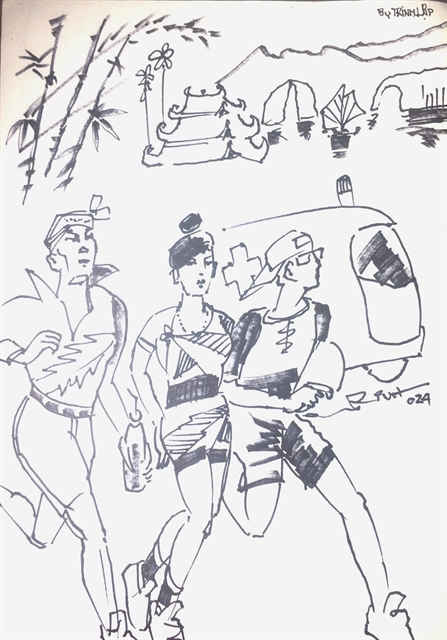 Talk Around Town
Talk Around Town


|
| Illustration by Trịnh Lập |
By Thanh Nga
The running movement is flourishing worldwide, and Việt Nam is no exception. With a growing number of participants and an abundance of running events, ensuring the safety of runners has become a pressing concern.
As passionate runners, we can attest to the transformative power of running. The thrill of being in a race surrounded by fellow runners, the exhilaration of pushing our limits, and the overwhelming sense of accomplishment when crossing the finish line are experiences that fuel our love for running.
Running has become a global phenomenon, and its impact on physical and mental wellbeing is remarkable. What makes running truly special is its inclusivity. Regardless of age, background, or fitness level, anyone can participate and reap the benefits. Running brings people together, fostering a sense of community and camaraderie that is truly inspiring.
However, as the number of running events continues to rise, it is crucial to address the safety concerns that come with them. Runners face various hazards, including traffic-related risks, inadequate course management, and insufficient medical support. These challenges must be tackled to ensure the wellbeing of participants.
Even sudden deaths occurred, that deeply saddened the victims' relatives, friends, and the running community.
At the 2024 Tây Hồ Half Marathon on April 14, there was a case of a runner experiencing a cardiac arrest and collapsing 100m before the finish line. Currently, this runner is being treated in the hospital, but their health condition has worsened.
Last month, the running community in Việt Nam was shocked to hear the news of a runner who died while participating in the Việt Nam Ultra Marathon in Hòa Bình Province.
In early March of this year, a 9th male grader in Quảng Bình showed signs of exhaustion and fatigue after completing a 200m running event at the district sports event. The medical team provided first aid and rushed him to the hospital emergency room, but unfortunately, he did not survive.
The causes of death while running are diverse, with the three most common causes being related to cardiovascular problems, electrolyte imbalances, and extreme heat weather conditions. Even a prestigious marathon like the London Marathon, which has been held 43 times, has reported 13 deaths due to such reasons.
The victims who have tragically died while participating in running races include both professional and amateur athletes of various ages. Many running tournaments, including those in Việt Nam, do not impose age limits on athletes and have separate competition categories for professionals and amateurs.
In some races, participants voluntarily declare their health status and sign liability waivers, which can make it challenging for organisers to have complete knowledge of participants' health conditions.
To promote a safe running experience, it is essential for runners to take precautions. Prior to a run, warm-up exercises and stretching are vital to prevent injuries. Wearing reflective gear, especially when running on roads, enhances visibility and reduces the risk of accidents. Staying hydrated and listening to one's body is also paramount, as fatigue and overexertion can lead to health complications.
Nguyễn Tiểu Phương, a sports industry professional with 17 years of experience and participation in top races worldwide, emphasises the importance of serious training when deciding to participate in running events. Nutrition, sleep, and rest should be approached scientifically, and a well-researched target strategy for participating in tournaments is necessary.
"Running is a cardiovascular sport, directly related to the heart, and everything related to the heart is related to survival. This sport requires harmony between the musculoskeletal system and the cardiopulmonary system. If one of the two is weaker than the other, incidents can easily occur during training or competition," Phương said.
"Our body can be considered a machine that requires programming to operate. To run a marathon, ultra, trail, or ultra trail, training accumulation is like programming. Our body needs to recognise all activities to regulate, whether it's running fast or slow, short or long distances, uphill or downhill, or in hot or cold weather."
Insufficient training accumulation coupled with participating in long-distance and long-duration running events in hot environments can put the body in a state of suspended status. The body has to process too much new information simultaneously, which it had never encountered before.
Heart attacks and heat strokes are the two most typical cases that can be fatal for runners on the track. Therefore, training plans must include long runs at a low heart rate, short runs at a high heart rate, medium-time runs at a moderate heart rate, and uphill runs.
Hoàng Nguyên Thanh, the marathon champion of the 31st SEA Games, emphasises careful warm-up, proper nutrition, and rest before training or competing. He also highlighted the importance of becoming familiar with the running track and competition conditions. As tournaments in Việt Nam often take place on steep roads and in hot weather, thorough preparation is crucial to avoid injuries and heat strokes during competition.
SEA Games champion Phạm Thị Hồng Lệ advises newbie runners to focus on mastering basic techniques and gradually increasing training volume to avoid injuries. Despite being a professional athlete herself, Lệ once fainted during a marathon at the 30th SEA Games due to exhaustion. She advises everyone to train adequately for the distance they will compete in.
Meanwhile, event organisers play a pivotal role in guaranteeing the safety of participants. Well-planned race routes, effective traffic management, and adequate medical support are crucial considerations. It is imperative for organisers to prioritise the wellbeing of runners by implementing participant limits, ensuring clear communication channels, and fostering a culture of safety.
Running is more than just a physical activity, it is a life-changing endeavour. By prioritising safety, we can ensure that the running movement continues to thrive, inspiring individuals to embark on their own transformative journeys. So, lace up your shoes, listen to your body, and embrace the joy of running while keeping safety at the forefront. VNS




